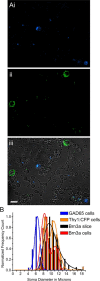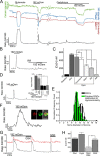The polymodal ion channel transient receptor potential vanilloid 4 modulates calcium flux, spiking rate, and apoptosis of mouse retinal ganglion cells
- PMID: 21562271
- PMCID: PMC3109951
- DOI: 10.1523/JNEUROSCI.0359-11.2011
The polymodal ion channel transient receptor potential vanilloid 4 modulates calcium flux, spiking rate, and apoptosis of mouse retinal ganglion cells
Abstract
Sustained increase in intraocular pressure represents a major risk factor for eye disease, yet the cellular mechanisms of pressure transduction in the posterior eye are essentially unknown. Here we show that the mouse retina expresses mRNA and protein for the polymodal transient receptor potential vanilloid 4 (TRPV4) cation channel known to mediate osmotransduction and mechanotransduction. TRPV4 antibodies labeled perikarya, axons, and dendrites of retinal ganglion cells (RGCs) and intensely immunostained the optic nerve head. Müller glial cells, but not retinal astrocytes or microglia, also expressed TRPV4 immunoreactivity. The selective TRPV4 agonists 4α-PDD and GSK1016790A elevated [Ca2+]i in dissociated RGCs in a dose-dependent manner, whereas the TRPV1 agonist capsaicin had no effect on [Ca2+](RGC). Exposure to hypotonic stimulation evoked robust increases in [Ca2+](RGC). RGC responses to TRPV4-selective agonists and hypotonic stimulation were absent in Ca2+ -free saline and were antagonized by the nonselective TRP channel antagonists Ruthenium Red and gadolinium, but were unaffected by the TRPV1 antagonist capsazepine. TRPV4-selective agonists increased the spiking frequency recorded from intact retinas recorded with multielectrode arrays. Sustained exposure to TRPV4 agonists evoked dose-dependent apoptosis of RGCs. Our results demonstrate functional TRPV4 expression in RGCs and suggest that its activation mediates response to membrane stretch leading to elevated [Ca2+]i and augmented excitability. Excessive Ca2+ influx through TRPV4 predisposes RGCs to activation of Ca2+ -dependent proapoptotic signaling pathways, indicating that TRPV4 is a component of the response mechanism to pathological elevations of intraocular pressure.
Figures








Similar articles
-
TRPV4 and AQP4 Channels Synergistically Regulate Cell Volume and Calcium Homeostasis in Retinal Müller Glia.J Neurosci. 2015 Sep 30;35(39):13525-37. doi: 10.1523/JNEUROSCI.1987-15.2015. J Neurosci. 2015. PMID: 26424896 Free PMC article.
-
Mouse retinal ganglion cell signalling is dynamically modulated through parallel anterograde activation of cannabinoid and vanilloid pathways.J Physiol. 2017 Oct 15;595(20):6499-6516. doi: 10.1113/JP274562. Epub 2017 Sep 7. J Physiol. 2017. PMID: 28766743 Free PMC article.
-
The expression and function of TRPV4 channels in primate retinal ganglion cells and bipolar cells.Cell Death Dis. 2019 May 7;10(5):364. doi: 10.1038/s41419-019-1576-3. Cell Death Dis. 2019. PMID: 31064977 Free PMC article.
-
Differential effects of TRPV channel block on polymodal activation of rat cutaneous nociceptors in vitro.Exp Brain Res. 2009 Jun;196(1):31-44. doi: 10.1007/s00221-009-1808-3. Epub 2009 Apr 30. Exp Brain Res. 2009. PMID: 19404626 Review.
-
From mechanosensitivity to inflammatory responses: new players in the pathology of glaucoma.Curr Eye Res. 2014 Feb;39(2):105-19. doi: 10.3109/02713683.2013.836541. Epub 2013 Oct 21. Curr Eye Res. 2014. PMID: 24144321 Free PMC article. Review.
Cited by
-
Vasculo-Neuronal Coupling and Neurovascular Coupling at the Neurovascular Unit: Impact of Hypertension.Front Physiol. 2020 Sep 25;11:584135. doi: 10.3389/fphys.2020.584135. eCollection 2020. Front Physiol. 2020. PMID: 33101063 Free PMC article. Review.
-
TRP Channels as Sensors of Bacterial Endotoxins.Toxins (Basel). 2018 Aug 11;10(8):326. doi: 10.3390/toxins10080326. Toxins (Basel). 2018. PMID: 30103489 Free PMC article. Review.
-
The Piezo1 ion channel in glaucoma: a new perspective on mechanical stress.Hum Cell. 2022 Sep;35(5):1307-1322. doi: 10.1007/s13577-022-00738-w. Epub 2022 Jun 29. Hum Cell. 2022. PMID: 35767143 Review.
-
TRPV4 overactivation enhances cellular contractility and drives ocular hypertension in TGFβ2 overexpressing eyes.bioRxiv [Preprint]. 2025 May 19:2024.11.05.622187. doi: 10.1101/2024.11.05.622187. bioRxiv. 2025. Update in: Elife. 2025 Jun 24;14:RP104894. doi: 10.7554/eLife.104894. PMID: 39574569 Free PMC article. Updated. Preprint.
-
Ultrasound Retinal Stimulation: A Mini-Review of Recent Developments.IEEE Trans Ultrason Ferroelectr Freq Control. 2022 Dec;69(12):3224-3231. doi: 10.1109/TUFFC.2022.3220568. Epub 2022 Nov 24. IEEE Trans Ultrason Ferroelectr Freq Control. 2022. PMID: 36343006 Free PMC article. Review.
References
-
- Agar A, Li S, Agarwal N, Coroneo MT, Hill MA. Retinal ganglion cell line apoptosis induced by hydrostatic pressure. Brain Res. 2006;1086:191–200. - PubMed
-
- Becker D, Blase C, Bereiter-Hahn J, Jendrach M. TRPV4 exhibits a functional role in cell-volume regulation. J Cell Sci. 2005;118:2435–2440. - PubMed
-
- Benfenati V, Amiry-Moghaddam M, Caprini M, Mylonakou MN, Rapisarda C, Ottersen OP, Ferroni S. Expression and functional characterization of transient receptor potential vanilloid-related channel 4 (TRPV4) in rat cortical astrocytes. Neuroscience. 2007;148:876–892. - PubMed
Publication types
MeSH terms
Substances
Grants and funding
LinkOut - more resources
Full Text Sources
Other Literature Sources
Molecular Biology Databases
Miscellaneous
